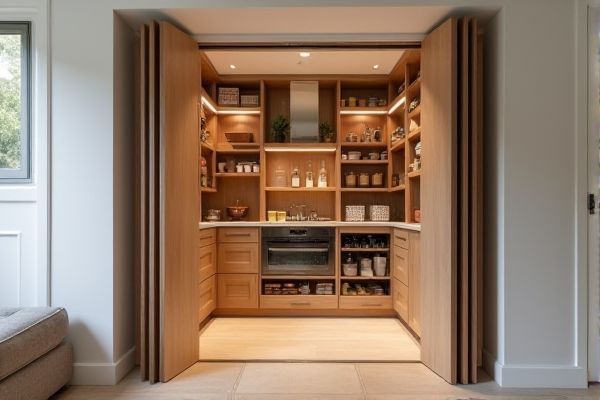
A ventilated pantry allows air circulation to prevent moisture buildup and keep your food fresh longer, while a sealed pantry maintains a controlled environment to protect items from pests and external odors. Understanding the benefits of each can help you optimize your storage space, so continue reading to find the best option for your kitchen needs.
Table of Comparison
| Feature | Ventilated Pantry | Sealed Pantry |
|---|---|---|
| Airflow | Allows continuous airflow to reduce moisture and odors | No airflow; airtight to prevent contamination and keep freshness |
| Humidity Control | Moderate humidity control via ventilation | Better humidity control due to sealed environment |
| Food Freshness | Keeps some foods fresh; not ideal for perishables | Prolongs freshness, ideal for perishable and dry goods |
| Pest Protection | Less effective; pests can enter via vents | High protection from pests due to airtight seal |
| Maintenance | Requires regular cleaning of vents | Needs occasional cleaning; easier to maintain dryness |
| Cost | Generally lower cost due to simpler design | Typically higher cost due to airtight construction |
Introduction to Pantry Design: Ventilated vs Sealed
A ventilated pantry promotes airflow to reduce humidity and prevent mold, ideal for storing fresh produce and dry goods in climates prone to moisture. Sealed pantries provide controlled environments by limiting air exchange, which helps preserve packaged and canned items by minimizing exposure to pests and contaminants. Choosing between ventilated and sealed pantry designs depends on factors like storage needs, climate conditions, and food preservation priorities.
What Is a Ventilated Pantry?
A ventilated pantry is designed with air circulation features such as vents or louvered doors to prevent moisture buildup and reduce the risk of mold and spoilage. This airflow helps maintain optimal storage conditions by regulating temperature and humidity levels, ensuring your dry goods stay fresh longer. Your choice between a ventilated pantry and a sealed pantry impacts food preservation and the overall kitchen environment.
What Is a Sealed Pantry?
A sealed pantry is an airtight storage space designed to protect food from moisture, pests, and contaminants by preventing air exchange. Unlike ventilated pantries, which allow airflow to reduce humidity and prevent mold, sealed pantries maintain a controlled environment ideal for long-term storage of dry goods and perishables. Your choice between a sealed and ventilated pantry depends on the food types you store and your preference for freshness preservation versus moisture control.
Humidity Control: Benefits of Ventilated Pantries
Ventilated pantries excel in humidity control by allowing air circulation, which prevents moisture buildup and reduces the risk of mold and mildew on stored food. This airflow helps maintain optimal freshness and prolongs the shelf life of perishable items by keeping the environment dry and cool. Your pantry's ventilation system is essential for preserving food quality and avoiding unpleasant odors caused by trapped humidity.
Pest Prevention: Advantages of Sealed Pantries
Sealed pantries offer superior pest prevention by eliminating gaps and cracks that insects and rodents can exploit to access food storage areas. Unlike ventilated pantries, which allow airflow but may inadvertently invite pests, sealed designs create a controlled environment that significantly reduces contamination risks. Rigid sealing methods combined with moisture control protect pantry contents from infestation and spoilage, ensuring higher food safety and hygiene standards.
Food Preservation and Shelf Life
A ventilated pantry allows air circulation that helps prevent moisture buildup and mold, extending the freshness of fruits and vegetables but may reduce shelf life for dry goods sensitive to humidity. A sealed pantry offers a controlled environment, protecting dry goods from pests and humidity fluctuations, significantly enhancing shelf life for staples like grains, flour, and canned foods. Choosing between the two depends on prioritizing fresh produce preservation or long-term storage of dry and canned goods.
Energy Efficiency Considerations
A ventilated pantry promotes airflow, reducing humidity and preventing mold, which can help maintain food quality without relying heavily on refrigeration. In contrast, a sealed pantry limits air exchange, potentially trapping heat and moisture, leading to higher energy consumption for cooling systems. Optimal energy efficiency is achieved by balancing ventilation to preserve food while minimizing the load on heating or cooling appliances.
Maintenance and Cleaning Requirements
A ventilated pantry requires regular upkeep to prevent dust buildup and maintain airflow, which helps reduce moisture and mold growth. In contrast, a sealed pantry demands thorough, less frequent cleaning to avoid trapped odors and pests but generally offers a more controlled environment. Your choice affects maintenance frequency--ventilated pantries need consistent checks, while sealed pantries benefit from occasional deep cleaning.
Cost Comparison: Installation and Long-Term Expenses
A ventilated pantry typically requires higher installation costs due to the need for proper airflow systems, while a sealed pantry generally involves lower upfront expenses with simpler construction. Over time, ventilated pantries may incur increased maintenance costs to ensure ventilation efficiency and prevent mold or moisture buildup, whereas sealed pantries often demand less frequent upkeep but may require more energy for consistent temperature control. Considering long-term expenses, sealed pantries can be more cost-effective in stable climates, while ventilated designs offer better durability and reduced spoilage in humid environments.
Choosing the Right Pantry for Your Home
A ventilated pantry improves air circulation, reducing moisture and keeping perishable items fresher longer, making it ideal for humid climates. In contrast, a sealed pantry offers better protection against pests and maintains a consistent environment for dry goods. Choosing the right pantry for your home depends on balancing moisture control with protection, ensuring your food storage meets your specific needs.
 homyna.com
homyna.com